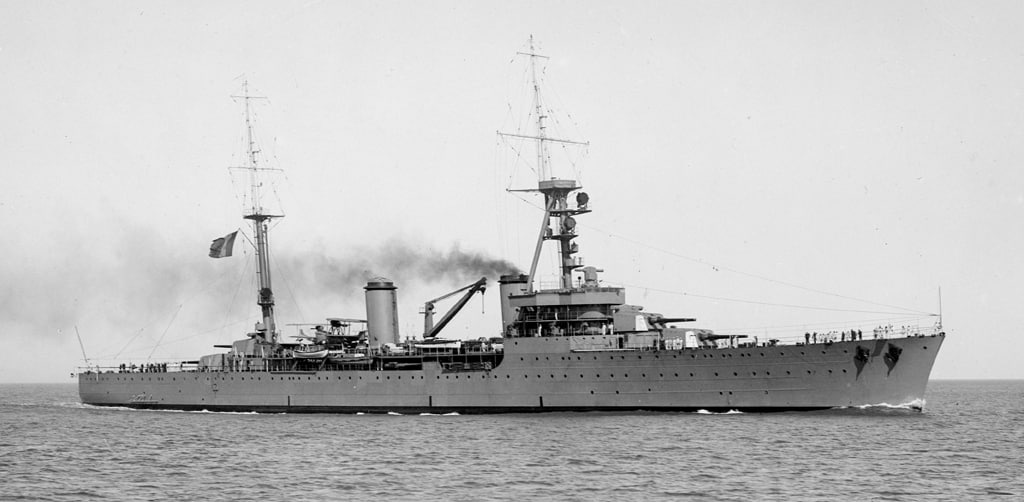
These first French heavy cruisers according to the 1922′ Washington treaty’s new definition, sacrificed protection for speed and were enlarged Duguay-Trouin class. They served in the Atlantic, then Force X in the Mediterranean, disarmed at Alexandria and rearmed and modernized in New York, soldiering with the FNFL until V-Day and Indochina afterwards.
Genesis of the Duquesne class
In 1918, the French navy was worn out, in material and moral crisis. It was necessary to rejuvenate it by new constructions as well as recruiting new sailors with better conditions for them to want to serve. Priority was for light cruisers and torpedo boats. Therefore after the Washington treaty was digested, the previously non-built FY1912 Croiseurs éclaireurs were replaced on the drawing board, emerging as the Duguay-Trouin class ships, in conformity with the treaty. The admiralty gave them the role of wing scouts and squadron leaders. With almost twice the tonnage of the 1912 cruisers, they were also more heavily armed with their 155mm battery and eight TTs. They were also much faster, but this came at a cost: Their flimsy protection and weak construction.
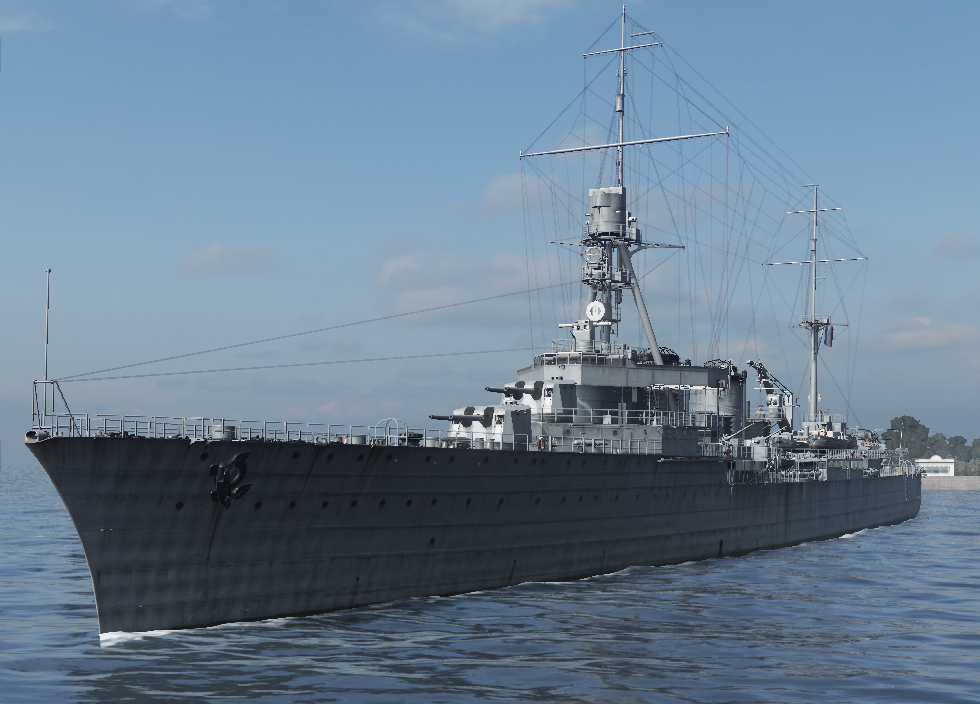
The Duguay-Trouin
Start of the transalpine rivalry
Meanwhile in 1922, Mussolini came to power in Italy. This event was soon known around the world as the rise of Fascism in Europe. France as a democratic Republic did not saw the transformation of her neighbour without concern nor apprehension, as much for future relations between both Transalpine countries, but also encouraging similar political turmoil in the hexagon itself. Quite quickly the Mediterranean ambitions of Mussolini, compounded by the Regia Marina’s equal rank to France, boasted the “Mare nostrum” objective with sole probable opponents being the French Navy. The rivaly between the two countries emerged and fed the comparisons, especially between cruisers. The first Italian Washington cruisers, the Giussano class, has been designed to catch and destroy French super-destroyers in the early 1920s. The next were to be heavy cruisers of the Trento class.
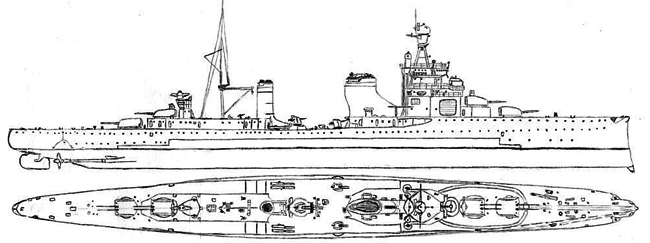
The Italian Guissano class
The French admiralty three light cruisers FY1922 gave moderate satisfaction, but even before they were completed, the admiralty wated to test the new Washington standard (10,000 tons, eight 203 mm (8-in) guns) as defined in article XI for the FY1924 program. More points were defined over maximal protection but nothing prevented speeds in excess of 30 knots. The Italians soon answered with the Trento class, one year later, also worthy to be called “tin-clad cruisers”.

https://en.wikipedia.org/wiki/Duquesne-class_cruiser
Design of the hull
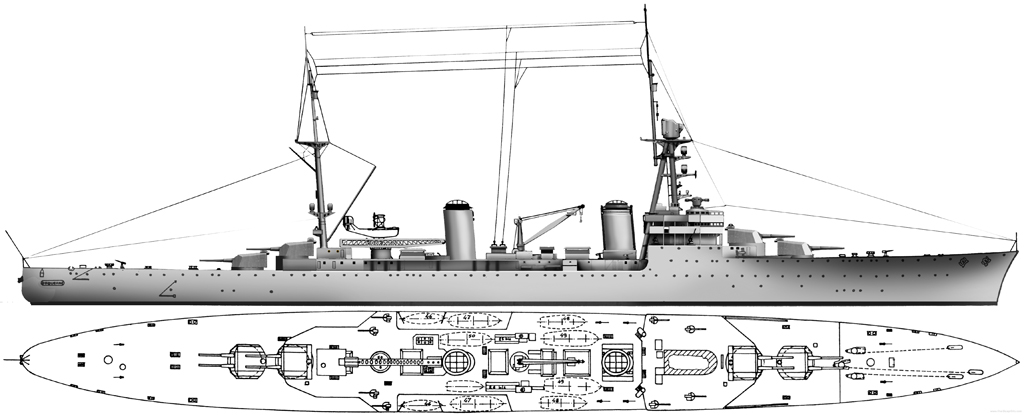
Author’s reworked profile of the Duquesne
The new class was to be fast, with modifications concerning the turrets and their barbettes, plus larger telemetric systems and slightly improved armour over the barbettes and ammunition rooms, plus extensive ASW compartmentation. The hull design mirrored the Duguay-Trouin class. Unlike some navies, with a high forecastle. The next Suffren adopted the same hull, until the Algérie took the flush-deck solution to spare hull weight for armour.
The two heavy cruisers were seaworthy, marine vessels but despite rheir roomy hull, comfort of the living quarters left to be desired and could have been better. Structural weaknesses at the foot of the forecastle were detected after trials and required bracing after commission. The superstructures called for a front heavy tripod around which the gangway is organized and different bridges setup. The two funnels were inclined at 5 ° to prevent smoke plumes interfering with the fire control station using classic optical systems.
The Duquesne class ships indeed did not possessed a rear fire station. The seaplane crane and catapult were located between those funnels. These ships carried 605 officers and sailors (637 as admiral ship).
Armament
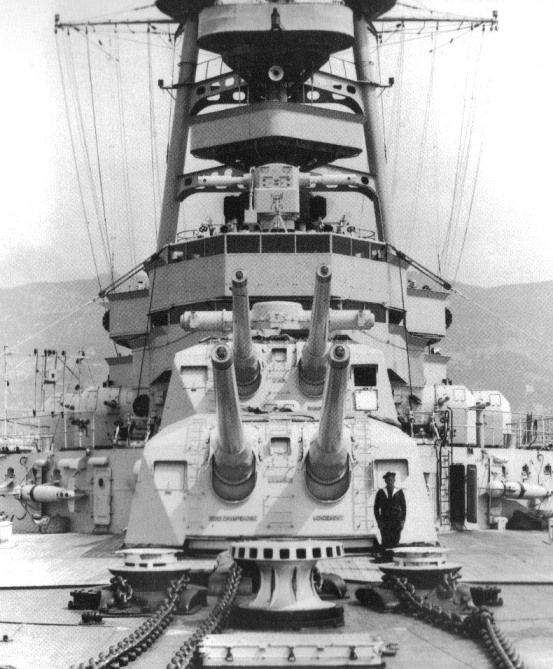
From view of the main artillery – Src Forummarine
Duquesne Main artillery
Artillery, comprised the first French 203mm guns (8-in) in service with the Marine Nationale, eight of them into four turrets in a classic configuration, in superfiring pairs fore and aft. These were twin mounts turrets, with independent elevation for each barrel. According to the forecastle, the aft pair was one deck lower. These were 203 mm/50 (8″) Model 1924, classic in manufacture with a thick autofretted ‘A’ tube, shrunk jacket and breech ring. These were fitted with a Welin breech-block wich opened upwards. These were 50 caliber, despite a tenacious legend stating the Algérie was given 55 caliber. The barrel length was 413.4 in (10.5 m) and the Chamber Volume 5,595 in3 (91.682 dm3).
Rate Of Fire was 4-5 rounds per minute on average. Ammunitions were the APC M1927: a 271.4 lbs. (123.1 kg) shell, or a 262.5 lbs. (119.07 kg) model, or the HE M1927: 273.0 lbs. (123.82 kg). They carried either a 17.8 lbs. (8.07 kg) AP warhead with Mélinite and for the HE 18.2 lbs. (8.3 kg). About 150 rounds were stored per gun onboard, so 1200 total. Loading could be performed at -5/+10 degrees and range was between 34,340 yards (31,400 m) for the AP and about 32,800 yards (30,000 m) for the HE shell. For the anecdote, the propelland charges of the Duquesne were colored in red, those of Tourville in Yellow. The total weight of the twin turret model 1924 in battle order was 180 tonnes, and it was electrically powered, with a -5°/+45° elevation (10° per second) and 150° traverse (6° per second).
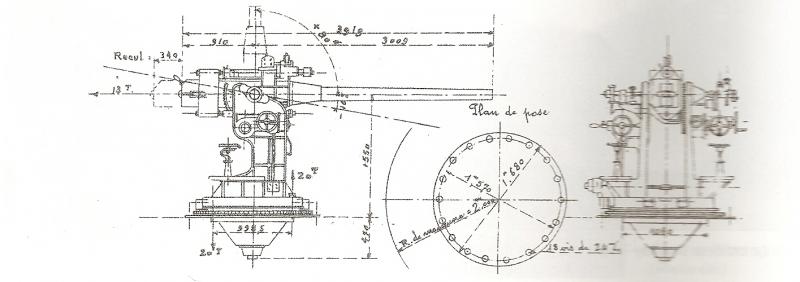
Canon de 75 Modele 1924 – Src unknown – FR forummarine
Duquesne Secondary artillery
This was completed by a serie of 75 mm guns (3 in), installed laterally in two groups of four. One group was placed at the front, two on either side of the bridge, and a rear group ith pairs on each side of the seaplane catapult. These were likely the 75 mm/50 (2.95″) Model 1924 (rather than 1922), which weighted 1.05 tons (1.07 mt), with a 147.6 in (3.75 m) barrel lenght. It could fire 8-15 rounds per minute, a fixed round 26.5 lbs. (12.01 kg)with a 13.07 lbs. (5.93 kg) warhead. The ammunition was 12.8 in (32.5 cm) in lenght, the complete round was 38.1 in (96.67 cm), fitted with a 4.81 lbs. (2.18 kg) BM5 propellant charge, in a 27.1 x 4.33 in (688.5 x 110 mm), 13.4 lbs. (6.08 kg) case. Muzzle velocity was 2,789 fps (850 mps). In theory these were dual purpose mounts but without fuse, the HE were almost useless against aviation (but some lucky direct hit), but with setup shrapnells. The Duquesne class carried (like the Suffren) no less than 500 rounds, including about 100-60 starshells of the OEcl Mle 1923 type for target illumination.
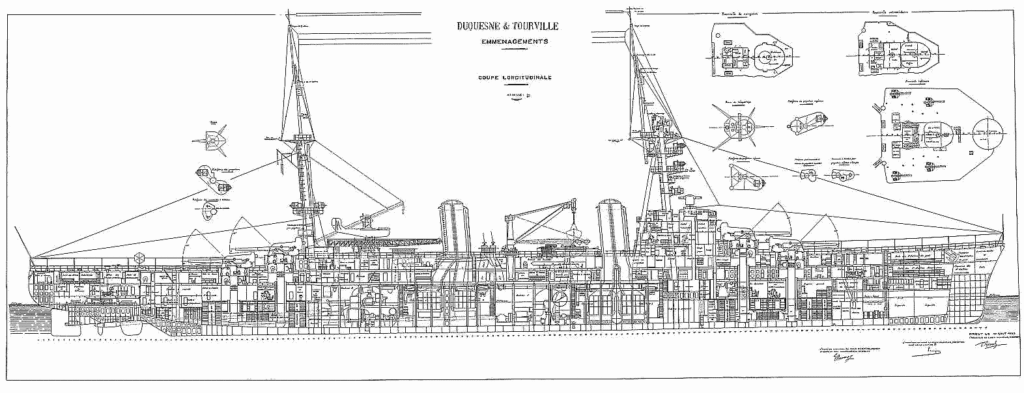
Cutaway original plan of the Tourville SRC
Duquesne-class light AA artillery
Interestingly enough, extra artillery was added after entering service: Eight 37mm 1925 model guns, 50-calibe were fitted in single mountings, two on the front deck, two on the beach aft and the last four on the shelter deck. These fired 0.725kg shells at 8,000 m in overall range and 5,000m at ax elevation in anti-aircraft mode. They fired at a rate of 20 rounds per minute. The 470 kgs mounts elevated from -15 ° to + 80 °, and 1000 rounds were provided per cannon, 8,000 total for the ship.
In 1933/34, the front and rear mounts were relocated on the shelter deck, either side of the boat crane. Four twin 13.2mm Hotchkiss machine guns model 1929 were installed, replacing the obsolete 8mm Hotchkiss machine guns model 1914. Two additional twin mounts were installed in 1937 this time with shields followed in 1940 by shields on the remaining mounts.
The initial 8mm Hotchkiss model 1914 fired 13 gram cartridges in rigid bands of 24 or articulated of 250 cartridges at max range of 2,400m. Apparently it came in single or twin 1916 mounts superimposed. The 13.2mm Hochkiss 1929 model was a 76-caliber cannon. Max range was range 3,500m, and practical rate of fire was 250 rounds/minute, due to the use of magazines of 30 cartridges. They existed in single, twin and even quadruple carriages.
There were also two quadruple 550 mm (21 in) torpedo tubes installed at the same level as the crane located between the two funnels. These were likely the 55 cm (21.65″) 23DT Toulon 1923 models, introduced in 1924. They weighted 4,560 lbs. (2,068 kg) for an overall Length of 27 ft. 2 in. (8.280 m), carrying an explosive Charge of 683 lbs. (310 kg) of TNT. The had a range of 9,840 yards (9,000 m) at 39 knots, or 4,200 yards (13,000 m) at 35 knots on the second setting. They were powered by a four-cylinder radial engine Schneider with an alcohol/air heater with the alcool acting as a diluent as well as a fuel source.
Fire control
As with the Duguay-Trouin class vessels, the Duquesne’s fire control system was not ready when the ships were completed. Sea trials are therefore done without. The main firing direction tower was divided into an upper and lower levels. The upper one contained the fire control team while the lower compartment contained the telemetry and calculation team and their table, calculator and isntruments.
The main rangefinder was a five-meter coincidence model located at the rear of the lower compartment. It was not installed until 1929-1930. The front part contained a 3 meters Zeiss stereoscopic rangefinder. The whole fire direction tower cold traverse at 360°. Before it was available, an older Triplex rangefinder was installed. Data collected by the telemeter was analyzed by a 1924 model analog computer whch was also installed at the start but soon replaced by two computers from Avisos.
In addition to the central fire control direction, were additional fire control teams, but no secondary fire control station. Indeed the aft turrets were both equipped with a 5 meters rangefinder. For night fighting illumination, four 1.2m diameter Sautter-Harlé projectors were installed port and starboard on the tripod mast and on the aft mast. They were remote-controlled in order to avoid dazzling their operators. Until 1932 both cruisers were devoid of any specific fire control for AA defence. This was solved during their first overhaul of 1932-1934. Two specific AA fire control systems were installed on board. These were 3 meters rangefinder, both with their own ballistic computer.
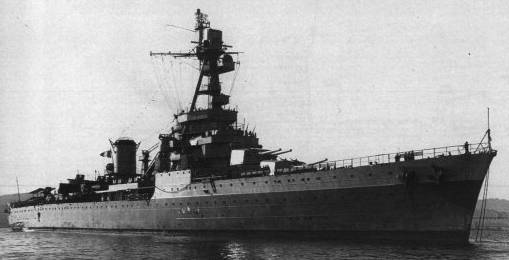
Tourville in 1945 – SRC
Airborne Artillery spotting
By default of a radar, artillery spotting and long range reconnaissance was assumed by a floatplane which changed over time. The first seaplane catapulting tests were carried out aboard the Primauguet, and was Penhoet looked for a place for the catapult it was necessary to find space, the only one available being on the rear turret. Very quickly this spot turned out to be mediocre because of the cannon blast and transfer from this to the hangar and wa complex and long operation. As a result on the Duquesne, this spot was moved between the second funnel and the rear mast. The latter carried the crane allowing to hoist the plane when recovering it.
During trials and early service life until 1930 the catapult was still not operational, and the FBA-17 et CAMS 37A carried onboard were hoisted at sea for taking off, necessitating a calm sea. After 1930, the operational catapult received a Gordou-Leseurre GL-810HY monoplane. It was replaced by a more modern (and larger) Loire 130. This obliged to fit in 1938 a brand new catapult, more powerful.
Propulsion
Like all ships of the time (or almost), Duquesne had a propulsion system composed of gear turbines supplied with steam by small water tubes boilers. The eight Guyot Du Temple tube boilers were manufactired at the Indret plant (near Nantes). The engine compartment was divided into two rooms with four boilers, the boiler rooms 1 and 2 evacuating their fumes through the first funnel, with truncated exhausts and the boiler rooms 3 and 4 though the second funnel, forward of the aft mast. These were connected to four groups of Rateau-Bretagne turbines. Due to the separate rooms they could operate independently of each other, providing an economical cruise. Each group included two main turbines including one with reverse gear. The two front groups drove the external propellers while the rear groups (cruising turbines) drove the internal propellers. Rated horsepower was 30,000 shp per group, for a total output of 120,000 shp. The four propellers were identical, three-blade 4.2 m diameter models. Electric power was supplied by two pairs of turbo-generators fed by the main propulsion’s steam plus two standard diesel-generators.
Sea Trials
As the Duquesne class was developed, they were hopes to reach 36 knots. Sea trials however showed a maximum speed of 34 knots could be achieved.
During a six hours trial on March 17, 1928, Tourville (displacing 11,395 tonnes) developed 126,918 shp, reaching a top speed of 33.23 knots on a distance of 700 nautical miles (1,400 km). Through forced heating during one 1 hour, on March 31, the Tourville, and with a displacement lowered to 9,646 tonnes, developed 136,742 shp, reaching 34.49 knots. There were also endurance tests by March 27 and 28, 24h of navigation at 30 knotswhich for the Tourville showed an average speed of 30.04 knots maintained over 1,800 nautical miles. Duquesne reached 34.12 knots on 131,770 shp but she was able to maintain 31 knots in the endurance test.
Protection
By far the least appealing aspect of these ships, which were first generation heavy cruisers, their protection was almost non-existent. The cursor was deliberately placed on speed over protection, and given the state of ballistic targeting science at the time, the admiralty considered that two-three knots were equivalent to 20 or 30 mm of extra armor. Of course if this was relatively true in 1924, the concept was no longer relevant in 1940 due to rapid progress in optics and ballistic computing. Fortunately for them, these cruisers never really duelled with other ships.
The hull was divided into seventeen watertight compartments, complete with their own ventilation and exhausts. Many could be flooded without much incidence on buoyancy. Bulkheads went placed from the bottom to the main deck, partitions also protected the engine rooms, reinforced by 20 mm steel plates, and 30 mm over the ammunition bunkers, while the bridge and waterline protective deck was only 20 mm strong (0.8 in). Propellers were protected by a a cover of 17 mm plates (0.6 in), while the conning tower and turret front received 30 mm thick armored steel plates (1.2 in).
Name
The class name related to Abraham Duquesne (1610 – 1688) a noble huguenot, famous marine officer in Louis XII and XIV Marine Royale. There was previously a 1880 masted cruiser Duquesne, and several line vessels before that. In the 1960s the name was given to a missile destroyer. The Tourville was named after Anne Hilarion de Tourville, French admiral under Louis XIV. In 1914 the name Tourville was given to the third unbuilt Lyon class battleships.
The Duquesne in service
Even before entering service, the heavy cruiser carried out a first “mission”, participating on July 3, 1928 in an important naval review organized in Le Havre with seventy-six other ships. From January 31 to August 3, 1929, Duquesne toured the African continent, visiting Dakar, Cape Town, Madagascar, Djibouti, and returned to the Mediterranean via the Suez Canal. She was part of the former ‘Levant Squadron’, which became the Mediterranean Sqn on July 20, 1921, then 1st Wing in 1927 and back to the Mediterranean Wing in 1939 and Mediterranean fleet in 1939.
By May 10, 1930 Duquesne was in Algiers, for the celebration of the hundredth anniversary of Algiers expedition together with Lamotte-Picquet, Primauguet, Suffren, and Colbert. In the 1920s the French navy studied the replacement of the old schoolship Jeanne d’Arc, pending future replacement. As the new school cruiser Jeanne d’Arc was under construction, a decision was made to distribute the officer cadets of the 1928 class among three heavy cruisers including Duquesne and Tourville. The division departed from Brest on October 6, 1930, arriving in Toulon on January 10, 1931 after a trip through the French Caribbean, Rio de Janeiro, Dakar and Casablanca. The second school cruise started on April 22 to July 10 in eastern Mediterranean.
By April 27, 1930, Duquesne and Suffren were in the 1st Light Division (1st DL), attached to a 1st line squadron, 1st Wing and by July 1931 the training cruise ended. Tourville Duquesne, Suffren and Colbert were reunited in May 1, 1931, Foch in December 1931 and Dupleix in December 1932, bringing the heavy cruiser division to its full strenght. By October 9, 1934, the division was deployed to secure the visit in Marseille aboard Dubrovnik of King Alexander I of Yugoslavia. Off Marseilles were posted the Forbin, Trombe, Mistral destoyers, and 70 nm away the Gerfaut, Chevalier Paul and Vautour. Duquesne and Colbert were also screened by no less than twelve submarines.
On October 19, 1934, Algeria arrived in Toulon, becoming the flagship of 1st Wing while light divisions were reorganized. The 1st LD comprised now the heavy cruisers Algeria, Dupleix and Colbert, and the 3rd LD Foch, Duquesne and Tourville while in May 1936 Foch was replaced by the Suffren.
In June 1935 off Douarnenez (Britanny) fifty-eight vessels participated in a review both including Duquesne. After the Spanish civil war broke out, Duquesne sailed to Barcelona on July 24, 1936, and started evacuating French expatriates. She participated in a large naval exercize off Brest in 1937, involving both squadrons, 41 ships pin total.
By October 1937, Her squadron was modified again, combining both heavy cruiser divisions. By February 1938, the 2nd Cruiser Division (Duquesne and Tourville) was attached to the School of Maritime Application (EATM), making a Mediterranean cruise until the summer of 1938. Maintenance was postponed as the Sudetenland crisis erupted, and later the Munich agreements, until October 1938-January 1939. Both cruisers were placed under the 3rd Wing in two divisions when the war broke out. They faced Italy, likely to engage alongside its German ally. Their first mission was to track down German raiders until April 15, 1940, in Force Y (Rear Admiral Bouxin) with the battleship Provence, the Cruisers Colbert, Emile Bertin and destroyer Bison, Milan and Epervier. It was based in Dakar to operate on the Atlantic.
Force X was then assembled and based in Alexandria to cover the eastern Mediterranean, initially with the battleships Provence, Bretagne and Lorraine, destroyers Tigre and Lynx plus other ships, assembled in May and activated when reinforced by the heavy cruisers Duquesne and Tourville.
Later the battleships Provence and Bretagne left for for Bizerte and Mers-El-Kébir, while Force X was reinforced by the Duguay-Trouin. This squadron headed for Beirut in several groups and assembled for an ill-fated raid in the Aegean Sea, returning in Egypt in June 13, 1940. Another raid was planned against the Sicilian coast in June 23-26 which was prevented by the armistice on June 22. The squadron was immibilized in Alexandria until Operation CATAPULT took place.
Fortunately in Alexandria, a British controlled harbour, things went mch better than in Mers-El-Kebir. Admirals Godefroy and Cunningham passed a gentleman’s agreement allowing internment and disarmament despite pressure from Vichy hierarchy. It was signed on July 7, 1940. From there, part of the crews were repatriated to France, while others deserted to join the Free French Naval Forces (FNFL) like Honoré d’Estiennes d’Orves, a future figure of the resistance. After Operation Torch in November and the rally of Morocco and Algeria to the allies and Tunisia remaining under Vichy control, the Germans sent reinforcements there to help hard-pressed Afrikakorps.

Duquesne in 1945 (navypedia)
However Force X would only join the allies in May 10, 1943, six months after TORCH. After three years without maintenance, the ships were in poor conditions. The US Navy consulted over a modernization of the “10,000 tonnes” French cruisers declared themselves not interested as the ships were considered too lightly built and protected to be effective. However they went through an overhaul nevertheless in Casablanca, limited to the strict necessary. The original AA was replaced by 20mm Oerlikon and 40mm Bofors guns, all in single mountings, while the TTs, planes and catapults were removed. The Duquesne and Tourville left Alexandria for Dakar via the Suez Canal and the Cape of Good Hope, arriving in September 1943. At first they concentrated on searching and destroying German blockade runners. They were part of the allied ‘Pernambuco-Freetown line’ which mobilized USN, French and even Italian cruisers. Eight patrols were made between September 1943 and February 1944.
Afterwards, the cruisers sailed to Casablanca for a modernization and new overhaul, then they headed for the better facilities of the Scottish port of Greenock, leaving it on August 25 and back to Casablanca. They carried transport missions between Casablanca, Gibraltar, Oran, Greenock and Cherbourg, Oran and Toulon. By November 1944, the obsolescent Duquesne was immobilized in Casablanca, but later joined the Atlantic French Naval Task Force (FNTF) to bring fire support to retake the Atlantic pockets, notably Lorient and Saint-Nazaire, left to the Free French and resistance.
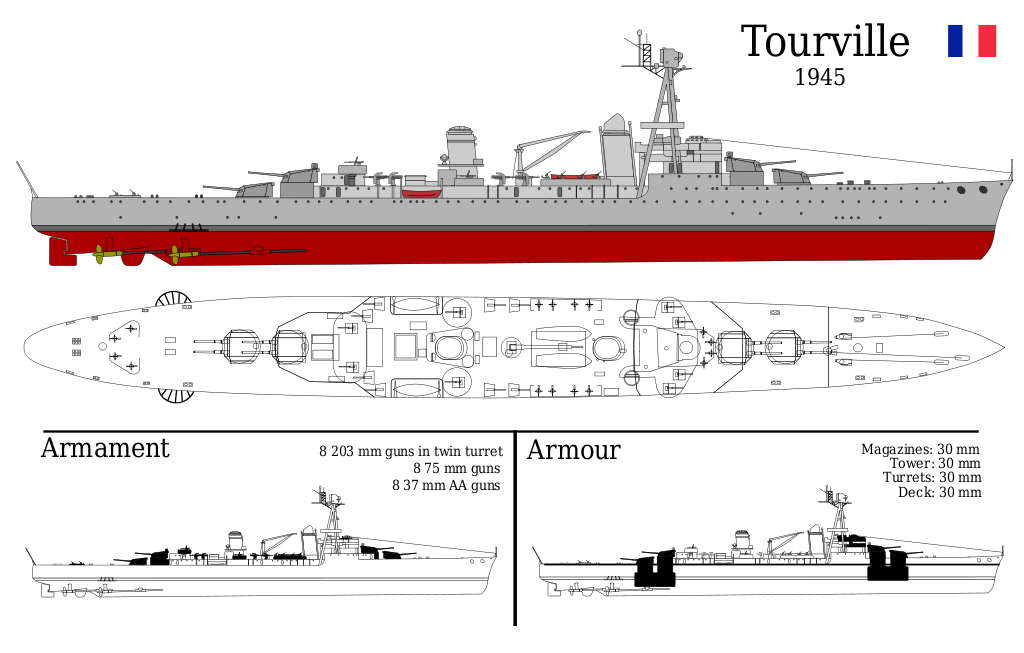
Tourville in 1945 (cc)
By December 1944, Duquesne and Gloire arrived in Brest and by January 1945, she was based in Cherbourg, until April. She was overhauled again, having modernized condensers, and two retubed boilers. She shelled the pocket of Royan and Pointe du Grave. She was resupplied at Casablanca and shelled the the island of Oleron in April 1945, in support to a French landing to subdue the German garrison. Soon afterwards in May, the French Naval Task Force (FNTF) was dissolved as the war ended in Europe.
Until November 1945 Duquesne was immobilized in Brest for an overhaul and will take part in the campaign in Indochina twice. The first ended in January 25, 1946, and she took part in the reconquest of Tonkin, also making rotations between Saigon and Tonkin. Her second deployment took place from January 17, 1947 and lasted three months. She was back in France by may. She notably shelled the the Tourane area to support ground operations. She was back into reserved in September 1947, attached to the Center for Instruction of Amphibious Operations in Arzew, Oran. She became a static ship-base in 1948 and served there for seven years discarded in 1955, as Q-52, towed to Mers-El-Kébir and sold for broking up in July 1956.
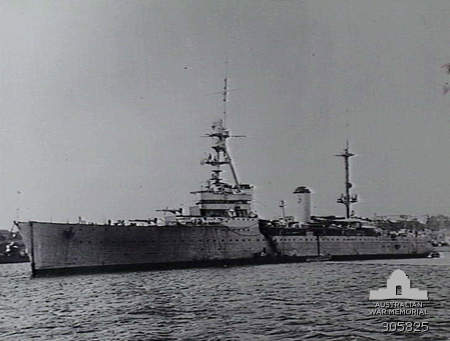
Duquesne, date unknown – Australian War Museum
The Tourville in service
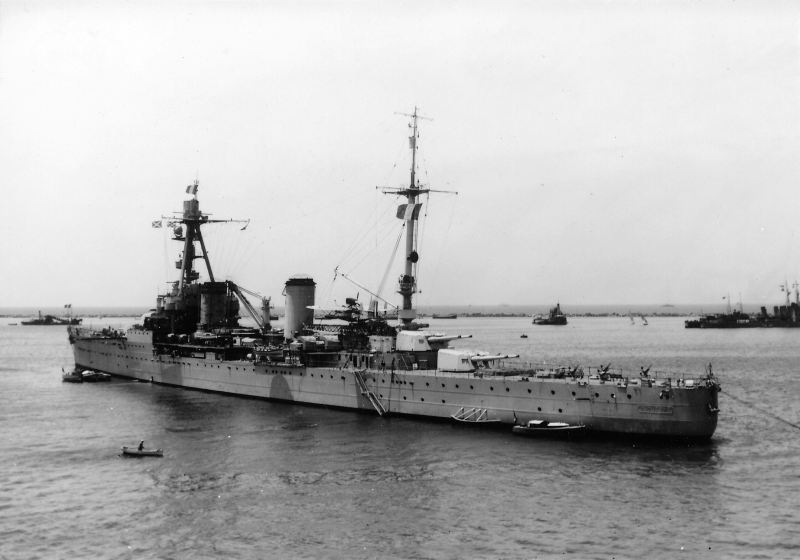
Duquesne, stern view credits: shipspotting.com
The Tourville was launched on August 24, 1926 and completed, trialled, in service by March 12, 1929. In July 3, 1928 already she took part in a naval review off Le Havre. By December 1929, she served in the Mediterranean’s 1st Light Division with her sistr ship and Suffren. Ths unit was changed several times afterwards; She also replaced the former old cruiser Quinet as schoolship before the Jeanne d’Arc was ready.
After the Béarn ws constructed there was some debate over converting unprotected cruisers into fast fleet carriers, as the Béarn was very slow. The admiralry was presented with four designs compatible with the 12,000 tons from the global allocation by the Washington treaty:
> With a 139m long flight deck:
Either 98 m/102 m long superstructure hangar and preserved 8-in lower front turret kept, or 102m first superstructure hangar and the lower rear turret of 203mm preserved.
> With a 176 m long flight deck: 116.50m hangar, no 8-in turret.
Capacity was enough to carry fourteen planes, and the ships were to received twelve 100 mm DP mounts and four 37 mm AA guns.
The weakness of the air group made the project dropped in favor of a dedicated design, the Joffre and Painlevé, never completed.
The conversion project resurface in 1945 by the influence of the USN Independence class, but the process would take much more longer.
Postcard – unknown origin, from pinterest
By June 1935 Tourville made an exercize off Douarnenez and in May 1937, took part in another exercize and naval review. She was in 1938 attached to the School of Maritime Application (EATM) and in July 1939, joined the 3rd Wing. From September, this squadron was composed of the Algeria, Dupleix, Foch and Colbert plus Duquesne and Tourville (2nd Division), tracking down German raiders.
In May 1940 she teamed up with Provence, Betagne and Lorraine, destroyers and TBs making the Force X based in Egypt at Port Said, later joining Beirut and from there, raided the Aegean Sea and back to Alexandria in June 13, 1940. After another raid on the Sicilian coast she was back to Alexandria and tied by the armistice to disarmament and inaction until late 1942 and the allied landings in French North Africa.

The Tourville going through the Panama Canal.
At that time she was worn out but the Americans refused to upgrade and overhaul her. Tourville was slightly overhauled at Casablanca, notably receiving modern AA like her sister-ship. She was based in Dakar to catch blockade runners. Her last patrol ended in February 1944. After maintenance in Casablanca she was back into service in June 3, 1944. As her modernization in the USA was still refused at that point she was disarmed locally, with a probable sale for demolition. She was saved this fate by being reactivated for participating in the Indochina campaign.
She served with the Maritime Forces in the Far East (FMEO) with the Duquesne, Tourville and Suffren, later the Naval Division of the Far East (DNEO).
She acted as a transport and fire support vessel. She shelled notably Cam-Ranh and Cap Saint Jacques, carried out Operation Bentré and the naval review of Halong Bay, followed by a short overhaul in Shanghai by June 1946. She made her last voyage from France and back in October 1946 to November 1947. She shelled the Tourane area, Annam and transported troops at Saigon. She was placed into reserve in 1948, served with the EOR (School of Reserve Officers) and EM (School of Maneuver) and was finally struck by April 28, 1961, broken up at La Seyne.

Old author’s rendition of the Duquesne 1/700
| Dimensions | 186,2 m long, 20 m wide, 6,15 m draught (611 x 66 x 20.2 ft) |
| Displacement | 10 000 t. standard -11,404 t to 12,436 tonnes Fully loaded |
| Crew | 800 |
| Propulsion | 4 shafts direct geared SR turbines Rateau-Bretagne, 8 Guyot/Du Temple boilers, 120,000 hp. |
| Speed | 34 knots (60 km/h) |
| Range | 5,000 nautical miles at 15 knots, 1800 at 29 knots, 700 at 33 knots, capacity 1842 tonnes of oil |
| Armament | 8 x 203 mm/55 (Mod. 1931), 12 x 100 mm DP (6×2), 8 x 37 mm AA (4×2), 16 x 13,2 mm AA HMGs (4 x 4), 2 x 3 550 mm TTs, 2 Loire 130 seaplanes. |
| Armor | Ammunitions holds 20/30mm, CT 30 mm, turrets 30 mm (1.5 in). |
Read More/Src
Gardiner Conway’s all the world’s fighting ships 1921-46.
Jean-Michel Roche, Dictionnaire des bâtiments de la flotte de guerre française de Colbert à nos jours.
forummarine.forumactif.com
amazon.fr Croiseurs-lourds-Francais-DUQUESNE-TOURVILLE/dp/2914017162
navweaps.com/
secondeguerre.net/ lourdduquesne.html
forummarine.forumactif.com croiseurs-lourds-classe-duquesne-france-termine
commons.wikimedia.org/wiki/Category:Tourville
memorial-national-des-marins.fr/ duquesne
data.bnf.fr/fr/16248170/duquesne__croiseur
drive.google.com/
3dhistory.de 1925DUQUESNE/
3dhistory.de/ 1926TOURVILLE/
the-blueprints.com/search/duquesne/
Detailed plans of the Tourville
The Models Corner. Wait to built amodel kit of the Duquesne or Tourville ?
1/700 resin kit by WSW in polyrethane SRC


 Latest Facebook Entry -
Latest Facebook Entry -  X(Tweeter) Naval Encyclopedia's deck archive
X(Tweeter) Naval Encyclopedia's deck archive Instagram (@navalencyc)
Instagram (@navalencyc)





 French Navy
French Navy Royal Navy
Royal Navy Russian Navy
Russian Navy Armada Espanola
Armada Espanola Austrian Navy
Austrian Navy K.u.K. Kriegsmarine
K.u.K. Kriegsmarine Dansk Marine
Dansk Marine Nautiko Hellenon
Nautiko Hellenon Koninklije Marine 1870
Koninklije Marine 1870 Marinha do Brasil
Marinha do Brasil Osmanlı Donanması
Osmanlı Donanması Marina Do Peru
Marina Do Peru Marinha do Portugal
Marinha do Portugal Regia Marina 1870
Regia Marina 1870 Nihhon Kaigun 1870
Nihhon Kaigun 1870 Preußische Marine 1870
Preußische Marine 1870 Russkiy Flot 1870
Russkiy Flot 1870 Svenska marinen
Svenska marinen Søværnet
Søværnet Union Navy
Union Navy Confederate Navy
Confederate Navy Armada de Argentina
Armada de Argentina Imperial Chinese Navy
Imperial Chinese Navy Marinha do Portugal
Marinha do Portugal Mexico
Mexico Kaiserliche Marine
Kaiserliche Marine 1898 US Navy
1898 US Navy Sovietskiy Flot
Sovietskiy Flot Royal Canadian Navy
Royal Canadian Navy Royal Australian Navy
Royal Australian Navy RNZN Fleet
RNZN Fleet Chinese Navy 1937
Chinese Navy 1937 Kriegsmarine
Kriegsmarine Chilean Navy
Chilean Navy Danish Navy
Danish Navy Finnish Navy
Finnish Navy Hellenic Navy
Hellenic Navy Polish Navy
Polish Navy Romanian Navy
Romanian Navy Turkish Navy
Turkish Navy Royal Yugoslav Navy
Royal Yugoslav Navy Royal Thai Navy
Royal Thai Navy Minor Navies
Minor Navies Albania
Albania Austria
Austria Belgium
Belgium Columbia
Columbia Costa Rica
Costa Rica Cuba
Cuba Czechoslovakia
Czechoslovakia Dominican Republic
Dominican Republic Haiti
Haiti Hungary
Hungary Honduras
Honduras Estonia
Estonia Iceland
Iceland Eire
Eire Equador
Equador Iran
Iran Iraq
Iraq Latvia
Latvia Liberia
Liberia Lithuania
Lithuania Mandchukuo
Mandchukuo Morocco
Morocco Nicaragua
Nicaragua Persia
Persia San Salvador
San Salvador Sarawak
Sarawak Uruguay
Uruguay Venezuela
Venezuela Zanzibar
Zanzibar Warsaw Pact Navies
Warsaw Pact Navies Bulgaria
Bulgaria Hungary
Hungary

 Bundesmarine
Bundesmarine Dutch Navy
Dutch Navy Hellenic Navy
Hellenic Navy Marina Militare
Marina Militare Yugoslav Navy
Yugoslav Navy Chinese Navy
Chinese Navy Indian Navy
Indian Navy Indonesian Navy
Indonesian Navy JMSDF
JMSDF North Korean Navy
North Korean Navy Pakistani Navy
Pakistani Navy Philippines Navy
Philippines Navy ROKN
ROKN Rep. of Singapore Navy
Rep. of Singapore Navy Taiwanese Navy
Taiwanese Navy IDF Navy
IDF Navy Saudi Navy
Saudi Navy Royal New Zealand Navy
Royal New Zealand Navy Egyptian Navy
Egyptian Navy South African Navy
South African Navy






























 Ukrainian Navy
Ukrainian Navy dbodesign
dbodesign
A few countries built ‘tinclad’ heavy cruisers to meet the requirements of the Washington Treaty, with the Duquesne class probably the worst of the lot. At least they never saw any action – their non-existent armour protection would have made them an easy target for better armoured enemy cruisers.